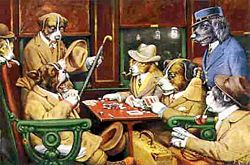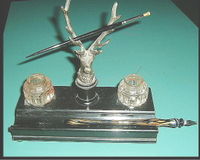Kitsch
2008/9 Schools Wikipedia Selection. Related subjects: Art
Kitsch /kɪtʃ/ is a term of German or Yiddish origin that has been used to categorize art that is considered an inferior, tasteless copy of an existing style. The term is also used more loosely in referring to any art that is pretentious to the point of being in bad taste, and also commercially produced items that are considered trite or crass.
Because the word was brought into use as a response to a large amount of art in the 19th century where the aesthetic of art work was associated with a sense of exaggerated sentimentality or melodrama, kitsch is most closely associated with art that is sentimental; however, it can be used to refer to any type of art that is deficient for similar reasons—whether it tries to appear sentimental, glamorous, theatrical, or creative, kitsch is said to be a gesture imitative of the superficial appearances of art. It is often said that kitsch relies on merely repeating convention and formula, lacking the sense of creativity and originality displayed in genuine art.
History
Though its precise etymology is uncertain, it is widely held that the word originated in the Munich art markets of the 1860s and ’70s, used to describe cheap, hotly marketable pictures or sketches (the English term mispronounced by Germans, or elided with the German dialect verb kitschen that originally meant “to scrape up mud from the street” or "to smear"). Kitsch appealed to the crass tastes of the newly moneyed Munich bourgeoisie who allegedly thought they could achieve the status they envied in the traditional class of cultural elites by aping, however clumsily, the most apparent features of their cultural habits.
The word eventually came to mean “a slapping together” (of a work of art). Kitsch became defined as an aesthetically impoverished object of shoddy production, meant more to identify the consumer with a newly acquired class status than to invoke a genuine aesthetic response. Kitsch was considered aesthetically impoverished and morally dubious, and to have sacrificed aesthetic life to a pantomime of aesthetic life, usually, but not always, in the interest of signalling one’s class status.
Avant-garde and kitsch
The word was popularized in the 1930s by the theorists Theodor Adorno, Hermann Broch, and Clement Greenberg, who each sought to define avant-garde and kitsch as opposites. To the art world of the time, the immense popularity of kitsch was perceived as a threat to culture. The arguments of all three theorists relied on an implicit definition of kitsch as a type of false consciousness, a Marxist term meaning a mindset present within the structures of capitalism that is misguided as to its own desires and wants. Marxists imagine there to be a disjunction between the real state of affairs and the way that they phenomenally appear.
Adorno perceived this in terms of what he called the “ culture industry,” where the art is controlled and formulated by the needs of the market and given to a passive population which accepts it—what is marketed is art that is non-challenging and formally incoherent, but which serves its purpose of giving the audience leisure and something to watch. It helps serve the oppression of the population by capitalism by distracting them from their alienation. Contrarily, art for Adorno is supposed to be subjective, challenging, and oriented against the oppressiveness of the power structure. He claimed that kitsch is parody of catharsis, and a parody of aesthetic experience.
Broch called kitsch “the evil within the value-system of art”—that is, if true art is “good,” kitsch is “evil.” While art was creative, Broch held that kitsch depended solely on plundering creative art by adopting formulas that seek to imitate it, limiting itself to conventions and demanding a totalitarianism of those recognizable conventions. To him, kitsch was not the same as bad art; it formed a system of its own. He argued that kitsch involved trying to achieve “beauty” instead of “truth” and that any attempt to make something beautiful would lead to kitsch.
Greenberg held similar views; believing that the avant-garde arose in order to defend aesthetic standards from the decline of taste involved in consumer society, and seeing kitsch and art as opposites. He outlined this in his essay “Avant-Garde and Kitsch.” One of his more controversial claims was that kitsch was equivalent to Academic art: “All kitsch is academic, and conversely, all that is academic is kitsch.” He argued this based on the fact that Academic art, such as that in the 19th century, was heavily centered in rules and formulations that were taught and tried to make art into something learnable and easily expressible. He later came to withdraw from his position of equating the two, as it became heavily criticized. While it is true that some Academic art might have been kitsch, not all of it is, and not all kitsch is academic.
Other theorists over time have also linked kitsch to totalitarianism. The Czech writer Milan Kundera, in his book The Unbearable Lightness of Being (1984), defined it as “the absolute denial of shit.” He wrote that kitsch functions by excluding from view everything that humans find difficult to come to terms with, offering instead a sanitised view of the world in which “all answers are given in advance and preclude any questions.”
In its desire to paper over the complexities and contradictions of real life, kitsch, Kundera suggested, is intimately linked with totalitarianism. In a healthy democracy, diverse interest groups compete and negotiate with one another to produce a generally acceptable consensus; by contrast, “everything that infringes on kitsch,” including individualism, doubt, and irony, “must be banished for life” in order for kitsch to survive. Therefore, Kundera wrote, “Whenever a single political movement corners power we find ourselves in the realm of totalitarian kitsch.”
For Kundera, “Kitsch causes two tears to flow in quick succession. The first tear says: How nice to see children running on the grass! The second tear says: How nice to be moved, together with all mankind, by children running on the grass! It is the second tear that makes kitsch kitsch.”
Academic art
Nineteenth century academic art is still often seen as kitsch, though this view is coming under attack from modern critics. Broch argued that the genesis of kitsch was in Romanticism, which wasn’t kitsch itself but which opened the door for kitsch taste, by emphasizing the need for expressive and evocative art work. Academic art, which continued this tradition of Romanticism, has a twofold reason for its association with kitsch.
It is not that it was found to be accessible—in fact, it was under its reign that the difference between high art and low art was first defined by intellectuals. Academic art strove towards remaining in a tradition rooted in the aesthetic and intellectual experience. Intellectual and aesthetic qualities of the work were certainly there—good examples of academic art were even admired by the avant-garde artists who would rebel against it. There was some critique, however, that in being “too beautiful” and democratic it made art look easy, non-involving and superficial.
Many academic artists tried to use subjects from low art and ennoble them as high art by subjecting them to interest in the inherent qualities of form and beauty, trying to democratize the art world. In England, certain academics even advocated that the artist should work for the marketplace. In some sense the goals of democratization succeeded, and the society was flooded with Academic art, the public lining up to see art exhibitions as they do to see movies today. Literacy in art became widespread, as did the practice of art making, and there was a blurring between high and low culture. This often led to poorly made or poorly conceived artworks being accepted as high art. Often art which was found to be kitsch showed technical talent, such as in creating accurate representations, but lacked good taste.
Secondly, the subjects and images presented in academic art, though original in their first expression, were disseminated to the public in the form of prints and postcards—which was often actively encouraged by the artists—and these images were endlessly copied in kitschified form until they became well known clichés.
The avant-garde reacted to these developments by separating itself from the aspects of art such as pictorial representation and harmony that were appreciated by the public, in order to make a stand for the importance of the aesthetic. Many modern critics try not to pigeonhole academic art into the kitsch side of the art/kitsch dichotomy, recognizing its historical role in the genesis of both the avant-garde and kitsch.
Postmodernism
With the emergence of Postmodernism in the 1980s, the borders between kitsch and high art became blurred again. One development was the approval of what is called “ camp taste.” Camp refers to an ironic appreciation of that which might otherwise be considered corny, such as singer/dancer Carmen Miranda with her tutti-frutti hats, or otherwise kitsch, such as popular culture events which are particularly dated or inappropriately serious, such as the low-budget science fiction movies of the 1950s and 60s. “ Camp” is derived from the French slang term camper, which means “to pose in an exaggerated fashion.” Susan Sontag argued in her 1964 Notes on “Camp” that camp was an attraction to the human qualities which expressed themselves in “failed attempts at seriousness,” the qualities of having a particular and unique style and of reflecting the sensibilities of the era. It involved an aesthetic of artifice rather than of nature. Indeed, hard-line supporters of camp culture have long insisted that “camp is a lie that dares to tell the truth.”
Much of Pop art attempted to incorporate images from popular culture and kitsch; artists were able to maintain legitimacy by saying they were “quoting” imagery to make conceptual points, usually with the appropriation being ironic. In Italy, a movement arose called the Nuovi Nuovi (“new new”), which took a different route: instead of quoting kitsch in an ironic stance, it founded itself in a primitivism which embraced the ugliness and garishness, emulating it as a sort of anti-aesthetic.
Conceptual art and deconstruction posed as interesting challenges, because, like kitsch, they downplayed the formal structure of the artwork in favour of elements which enter it by relating to other spheres of life.
Despite this, many in the art world continue to have an adherence to some sense of the dichotomy between art and kitsch, excluding all sentimental and realistic art from being considered seriously. This has come under attack by critics who argue for a reappreciation of Academic art and traditional figurative painting, without the concern for it appearing innovative or new. As in the surreal and figurative paintings of Lawrence Hollien. A different tactic is taken by the Norwegian artist Odd Nerdrum, who composed a manifesto entitled “ On Kitsch,” where he makes a point of declaring himself a Kitsch painter rather than an artist, even though very few critics would actually think of his artwork as kitsch.
In any case, whatever difficulty there is in defining its boundaries with art, the word “kitsch” is still in common usage to label anything felt in bad taste.
The concept of the “kitsch-man”
The term “kitsch-man” (or Kitschmensch) refers to an individual who compulsively metamorphoses all of his aesthetic experiences into kitsch, regardless of whether the work of art concerned is good or bad. Whenever the kitsch-man contemplates art, it always involves the adoption of a particular viewpoint, a perspective swamped with the vicarious and the sentimental. When the kitsch-man encounters a genuine artwork and its kitsch replica (e.g. a twelve-inch copy of Michaelangelo’s pieta in plaster) the response elicited will be no different. Pathos is projected onto genuine works of art, transforming art from the past into objects of sentimentality. Even nature is not immune to kitsch under the apprehension of the kitsch-man, in particular those components of nature that have endured kitsch portrayals to the extent that they have become hackneyed. A sunset, for example, could too closely resemble its representation in cheap paintings or “romantic” films; here the kitsch-man makes natural occurrences seem “false.”
Examples
One of the first painters that served as a demonstrative example of kitsch is the Hungarian Charles Roka. Despised by the art world, he was nevertheless loved by the people. He became famous for his numerous variations of the Gipsy Girl, where he painted exotic looking Gypsies in a pin-up style, and for sentimental portraits of children with their pet dogs.
A modern example of a painter considered by most art critics and academics to be producing kitsch, but who has a loyal following that generally does not claim artistic sophistication, is the commercially successful American Thomas Kinkade, who brands himself the “Painter of Light™” and claims to be the United States’ “most collected living artist.” Kinkade paints scenes of stone cottages, lighthouses, cobble stone streets, rustic villages, and other vistas, with emphasis on the glittery ornamentation in the play of light and natural foliage. His work is meant to be sentimental, patriotic, quaint, spiritual, and inspirational. In the United Kingdom the artist Maggi Hambling is considered by many to be an unconscious exponent of kitsch, with the coffin-like Oscar Wilde memorial and the controversial Scallop sculpture (however, Hambling’s portraits of the dying Henrietta Moraes escape such critical accusation). Perhaps the closest British equivalent of Kinkade is the kitsch painter Jack Vettriano.
Several Dogs Playing Poker paintings produced in the early 20th century by C. M. Coolidge are famous examples of kitsch.
A painter classified as making kitsch is Margaret Keane, who worked in the ’50s and ’60s, painting mostly portraits of waif children; but whether her subject was child, adult, or animal, all of her pictures had very large, staring eyes that always directly faced the viewer.
Another painter who is commonly used as an example of kitsch is the fantasy artist Boris Vallejo, born in Peru. His painting involves muscular heroes, voluptuous ladies, and monsters, all depicted in a fantasy setting. Vallejo’s works and similar ones are often painted on the sides of vans and featured in calendars. Critics of his paintings find them garish and gaudy in similar ways to Siegfried and Roy shows in Las Vegas.
The works of Frank Frazetta have sometimes been identified as kitsch, but that classification has been disputed and is a matter of sometimes heated debate.
David Ligare and Bev Doolittle are good examples of the extent of kitsch.
Velvet paintings, which are widely sold in rural U.S. usually have kitsch themes. They often depict images of Elvis Presley, Dale Earnhardt, John Wayne, Jesus, Native Americans, and Cowboys. One example of a kitsch velvet painting features an 18-wheel truck driving through the night with a ghostly image of Jesus in the sky watching protectively from above.
Some kitsch items, typically small statuettes, deviate from the original concept, such as a Santa Claus in biker garb riding a chopper. Commonly, they can also be found bearing unrelated symbols, such as the motorcycle Santa wearing Green Bay Packers colors and logo.
The musicians whose work may be considered kitsch are Stockholm Syndrome, Creed, Kid Rock, Nickelback, Modern Error, and Telekinesis for Cats. The Eurovision Song Contest is considered by some to be an example of kitsch. One could also consider such music to be examples of the closely related concept of camp.
Las Vegas is considered by many the pinnacle of architectural kitsch in the world, and may be used as good example of how luxury and kitsch can be together. 1959 Cadillacs also seem to illustrate this.
The plastic pink flamingo lawn icon, popularized in the 1950s, has been reviled as kitschy bad taste or revered as retro cool.
These are only strong, defining examples of what art purists refer to as kitsch—many would say that it saturates all popular culture, and some would equate popular culture and kitsch as being one and the same; as Clement Greenberg remarked, kitsch is “all that is spurious in the life of our times" (from "Avantgarde and Kitsch", in Greenberg 1989).
Quotations
- “Kitsch is mechanical and operates by formulas. Kitsch is vicarious experience and faked sensations. Kitsch changes according to style, but remains always the same. Kitsch is the epitome of all that is spurious in the life of our times.”— Clement Greenberg, “ Avant-Garde and Kitsch,” 1939.
- “The more romantic a work of art, or a landscape, the quicker its repetitions are perceived as kitsch or ‘slush.’ ” — Arthur Koestler, 1949
- “[K]itsch is the absolute denial of shit, in both the literal and figurative senses of the word; kitsch excludes everything from its purview which is essentially unacceptable in human existence.”— Milan Kundera, 1984
- “Kitsch is the expression of passion at all levels, and not the servant of truth. It keeps relative to religion and truth...Truth, kitsch leaves for (modern) art. In kitsch skill is the important criteria...Kitsch serves life and seeks the individual.” Odd Nerdrum, “Kitsch—The Difficult Choice,” 1998.
- “I think that what’s truly vulgar is kitsch, that means the lack of technical awareness.”— Daniele Luttazzi, 1 February 2001 interview at L’Espresso.
- “The absence of kitsch makes life unbearable”— Friedensreich Hundertwasser
- “They say that romance is back in fashion, they say that kitsch is back in fashion.”— ( Brian Molko, during live performance of the song “Kitsch Object”)
- "It's kitschy!"— Cosmo Kramer
- "You wanna be rich, You wanna be Kitsch," ( Damien Rice Women like a Man)


